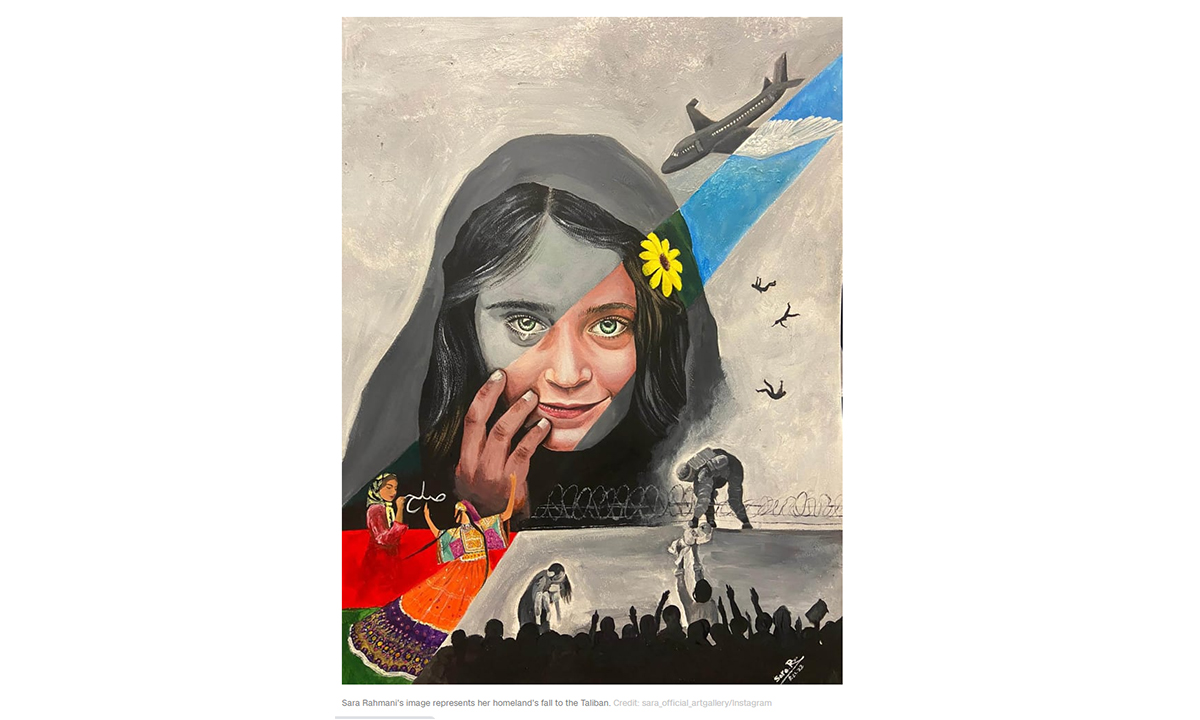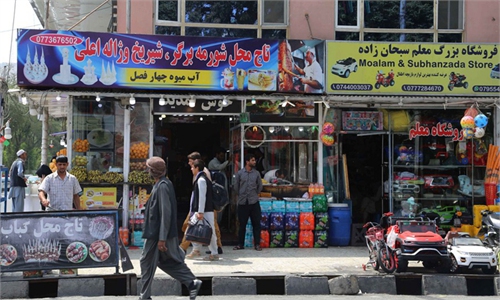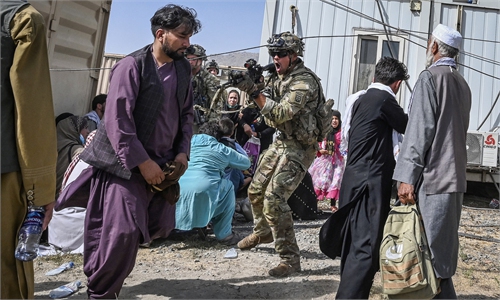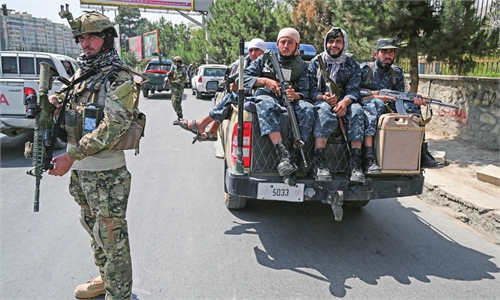
Screeshot:Sara Rahmani's image represents her homeland's “fall” to the Taliban. Credit: sara_official_artgallery/Instagram
As the hasty withdrawal of the US and its Western allies from Afghanistan finally laid to rest a 20-year-old war that has ended in failure, Western media have published a series of "stories" about Afghanistan supposedly told by ordinary people. This shows that they are not reconciled to their failure in Afghanistan, and that they are determined to describe their failure as a "noble" move attempting to save Afghans through storytelling.
For example, CNN on Monday published an article entitled, "Young Afghan artist creates haunting image of her homeland's fall to the Taliban." It's a story about Sara Rahmani who came to the US four years ago with her family from Afghanistan. CNN said now Rahmani is going to a civil engineering school in the US, and enjoys art as a hobby. In the report, she expresses her anger toward the Taliban and reverence to the US through drawing.
In the painting shown in the CNN report, she drew a girl with a green scarf. Rahmani explained that the green is "the color of peace, joy and happiness for Afghans." "It's a blue sky full of peace, sunny days, happiness and birds flying instead of army airplanes," she said.
The bottom right in gray are depictions of the desperate people who reportedly fell from a US military aircraft during the chaotic evacuation of Kabul, according to CNN. Beneath them are "people waiting at the gate of the airport with the paperwork, and some of them with nothing ... and the guy who is just trying to send his baby (over the fence) to make sure his next generation is in peace," Rahmani was quoted as saying.
She continued, "To be in America, I feel better here. But at the same time, it's not your country… I want the world to know that... there are innocent people who are getting killed. They lose mothers, they lose kids... when is this going to end?"
We have often seen such stories from the Western media throughout the Afghan war. But as a matter of fact, these are the stories of one American after another, and they are not directly related to what the Afghans really feel in Afghanistan.
The same pattern can be seen in the popular novel Kite Runner, which was written by Afghan-American author Khaled Hosseini. Nobel Peace Prize laureate Malala Yousafzai is another example. She was born in Pakistan and was shot in the head and neck by a Taliban gunman in Pakistan in 2012 after campaigning for girls to be educated in the country. The core of Yousafzai's narrative is the opposition between the "civilization" brought along by the West and the "ignorance" of Afghanistan itself. The West's intervention is a "salvation" for the Afghans.
The narrators living in the West tend to "look down" on their miserable homeland. The Afghans have no autonomy at all and their future depends just on the West.
The Western perspective in Rahmani's story is way too evident. She presents a distorted narrative by confusing the essence of the problem, namely the occupation forces had brought peace and civilization to Afghanistan. But as a matter of fact, what the occupation forces had brought to Afghanistan was exactly the war itself.
No one assumes that the Afghan society would be perfect without foreign invaders, but it is simply a false statement to rest on US occupation to "save" Afghans. Afghanistan's social progress cannot be achieved by foreign aggression, and the solution to the Afghan issue can only result from the efforts and choices the Afghans themselves would make.
Western media have tried to depicte the invasion as a "blessing" for Afghans. But what the stories attempt to dissemble is that as soon as the US troops withdrew, the Afghan government would immediately collapse, and the contradiction between the government and Afghan society would be exposed in no time. Now that the US promised to "save" Afghans, why have they failed to get the approval from the Afghan society? How could an incompetent government that even Americans have admitted to being riddled with corruption be a "blessing" to Afghans?
This explains why stories from the Western perspective cannot explain the real reason for the debacle. Nor can they provide the real Afghan situation via emotional narratives. Instead, the West can only cover for its responsibility of policy failures by virtue of migrants' narratives.
We should pay attention to the conventional expressions and the ability to tell stories of the West shown in this example. They can even portray a debacle as a personal story of a sentimental Afghan immigrant. In these stories, there are no real Afghans living in Afghanistan, but the characters are described as symbols of their miserable fate under the Taliban governance.
Such approach of distortion, confusion, and coverup of real problems is essentially an attempt to whitewash and beautify the notion of colonialism. The widespread application of this is part of Western "soft power." The problems of a nation were turned into its "original sin." And the failure of the West to rescue it is been regarded as the misfortune of the nation. The story is about illusory "truth," and the real problem is reduced to the contradiction between the superiority and the goodwill of the West and suffering of other countries.
The West has repeatedly exploited such methods to describe other third world countries, which deserves our attention.
The author is a professor at Peking University. opinion@globaltimes.com.cn



